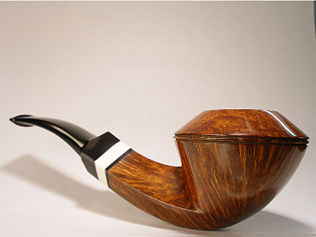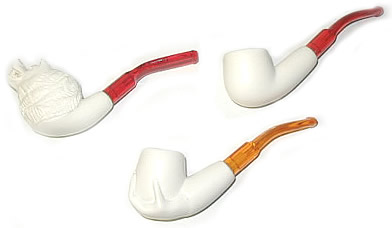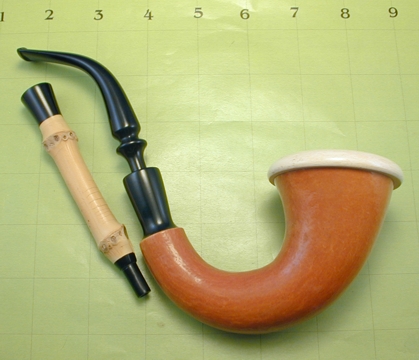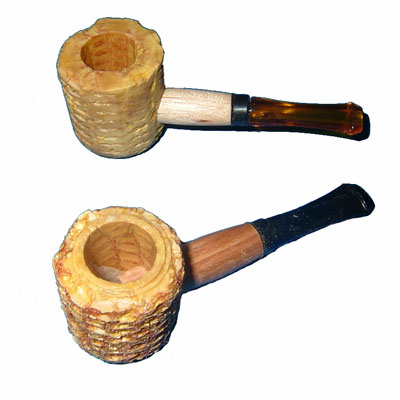Main Page: Difference between revisions
| Line 48: | Line 48: | ||
=== [[Pipe care/cleaning]] (also repairs) === | === [[Pipe care/cleaning]] (also repairs) === | ||
=== [[Pipe Tobaccos]]=== | === [[Pipe Tobaccos]]=== | ||
=== [[Pipe Marks & Logos]] === | |||
=== [[Pipe Making]] === | === [[Pipe Making]] === | ||
Revision as of 12:16, 24 July 2007
The scope of Pipedia will ultimately be defined by its contributors. Our hope in setting it up is that it will become an extensive repository of information on tobacco pipes and their makers. Knowledgeable enthusiasts, collectors, pipe makers, and tobacconists are welcome and encouraged to contribute to Pipedia. Please click the "discussion" tab above if you'd like to dialog with the contributors about the project.
Tobacco pipes come in many shapes and styles. For an excellent chart showing classic pipe shapes, see the chart by Bill Burney: Pipe Shapes. To see an excellent chart showing pipe parts along with their names, also by Bill Burney, see Pipe Parts.

Materials and construction
The basis for this section is from the Wikipedia entry Smoking Pipe (tobacco). The material and shape of a pipe has a profound influence upon the aesthetic of a smoke.
Briar
The majority of pipes sold today, whether hand made or machine made, are fashioned from briar. Briar is a particularly good wood for pipe making for a number of reasons. The first and most important is its natural resistance to fire. The second is its inherent ability to absorb moisture. The burl absorbs water in nature to supply the tree in the dry times and likewise will absorb the moisture that is a byproduct of combustion. Briar is cut from the root burl of the tree heath (Erica arborea), which is native to the rocky and sandy soils of the Mediterranean region. Briar burls are cut into two types of blocks; ebauchon and plateaux. Ebauchon is taken from the heart of the burl while plateaux is taken from the outer part of the burl. While both types of blocks can produce pipes of the highest quality, most artisan pipe makers prefer to use plateaux because of its superior graining.
Meerschaum
Meerschaum (hydrated magnesium silicate), a mineral found in small shallow deposits mainly around the city of Eskişehir in central Turkey, is prized for its plasticity which allows it to be carved into many decorative and figural shapes. It has been used since the 17th century and, with clay pipes, represented the most common medium for pipes before the introduction of briar as the material of choice in the 19th century.
The word "meerschaum" means "sea foam" in German, alluding to its natural white color and its surprisingly low weight. Meerschaum is a very porous mineral that absorbs elements of the tobacco during the smoking process, and gradually changes color to a golden brown. Old, well-smoked meerschaum pipes are prized for their distinctive coloring.
In selecting a meerschaum pipe it is advisable to take assurances that the product is indeed carved from a block of meerschaum, and is not made from meerschaum dust collected after carving and mixed with an emulcifier then pressed into a pipe shape. These products are not absorbent, do not color, and lack the smoking quality of the block carved pipe.
Clay
Clay in this case is almost always a very fine white clay. Low-quality "clay" pipes are actually made from porcelain forming techniques known as slip, and poured into a mold. These are porous, of very low quality, and impart unwanted flavors to a smoke. Top-notch clays, on the other hand are made in a labor-intensive process that requires beating all air out of the clay, hand-rolling each pipe before molding it, piercing with a fine wire, and careful firing. Traditionally, clay pipes are un-glazed. Clays burn "hot" in comparison to other types of pipes, so they are often difficult for most pipe-smokers to use. Their proponents claim that, unlike other materials, a well-made clay pipe gives a "pure" smoke, with no flavor addition from the pipe bowl. In addition to aficionados, reproductions of historical clay styles are used by some Historical re-enactors. Clay pipes were once considered disposable items and the large quantities discarded in the past are often used as an aid in dating by industrial archaeologists.
Calabash
Calabash gourds (usually with meerschaum or porcelain bowls set inside them) have long made prized pipes, but they are labour-intensive and nowadays quite expensive. Because of this expense, pipes with bodies made of wood (usually mahogany) instead of gourd, but the same classic shape are sold as calabashes. Both wood and gourd pipes are functionally the same. They both have an air chamber beneath the bowl which serves to cool, dry, and mellow the smoke. There are also briar pipes being sold as calabashes. These typically do not have an air chamber and are named only because of their external shape.
The construction of a calabash pipe generally consists of a downward curve that ends with an upcurve where the bowl sits. This low center of gravity allows for the user to easily hold the pipe by the mouth alone, leaving his hands free. This advantage was often used by actors who wanted to depict their character smoking while permitting them to do other business simultaneously. That is why the character Sherlock Holmes, who never used this kind of pipe in the stories, is stereotypically depicted as favoring it because early dramatic productions, especially those starring William Gillette and Basil Rathbone, made this artistic decision. In fact, Holmes, who preferred very harsh tobacco, would probably have disliked the calabash because of the above-mentioned mellowing effect.
Gourds specifically intended for pipemaking are usually "hand trained" while they are still green & growing. Every few days, after the fruit has begun to develop, the grower will bend the "neck" of the gourd, until it has formed into a near semi-circle.
Family: Cucurbitaceae (koo-ker-bih-TAY-see-ay)[1]
Genus: Lagenaria (lag-en-AR-ee-uh)[2]
Species: Siceraria (sy-ker-AR-ee-uh)[3]
Cultivar: Dipper(?)
Corncob
On the other end of the scale, "corncob" pipes made from maize cobs are cheap and effective, even if some regard them as inelegant. The cobs are first dried for two years. Then they are hollowed out to make a bowl shape. The bowls are dipped in a plaster-based mixture and varnished or lacquered on the outside. Shanks made from pine wood are then inserted into the bowls. The first and largest manufacturer of corncob pipes is Missouri Meerschaum, located in Washington, Missouri in the United States.[4]. Missouri Meerschaum has produced the pipes since 1869. General Douglas MacArthur and George Lincoln Rockwell were perhaps the most famous smokers of this type of pipe, along with the cartoon characters Popeye and Frosty the Snowman.
Corncob pipes remain popular today because they are inexpensive and require no "break-in" period like briar pipes. For these two reasons, corncob pipes are often recommended as a "Beginners pipe." But, their enjoyment is by no means limited to beginners. Corncob pipes are equally valued by both learners, and experienced smokers who simply desire a cool, clean smoke. Pipesmokers who wish to sample a wide variety of different tobaccos and blends also might keep a stock of corncobs on hand to permit them to try new flavors without "carryover" from an already-used pipe, or to keep a potentially bad tasting tobacco from adding its flavor to a more expensive or favored pipe.
Subsections under development
Pipe Packing and Smoking techniques (Beginning Pipe Smoking)
Pipe care/cleaning (also repairs)
Pipe Tobaccos
Pipe Marks & Logos
Pipe Making
Pipe makers by location
It would be great to see an overview and history of pipe making heading up each region. Please feel free to contribute information to the individual sections. Pipe makers in red still need bios (just click on them and add any information you have), and the others linked in blue could be expanded on. Feel free to add other pipe makers you've a particular interest in or knowledge of. Please let me know if you need any help managing the wiki: mailto:sethile.pipes@gmail.com
Canada
Canadian pipe making is very individual. Some styles are very traditional, showing definite Old World roots, while others are heavily influenced by the Danish freehand movement.
Canadian makers: John Calich (J.Calich) | Stephen Downie | Julius Vesz | Michael Parks
Denmark
We highly recommend the following article on the history of Danish pipe making by Jakob Groth. More Pipe maker articles coming soon to this section. Those in red still need articles. Please dive in if you'd like to help. Very thankfully there exists an excellent site dedicated to Scandinavian pipe makers. We highly recommend danishpipemakers.com
Danish pipe makers (alphabetical by last name)
A-B: Kurt Balleby | S. Bang (see also Per Hansen and Ulf Noltensmeier) | Knud Bech | Leo Børgart
C-G: Jess Chonowitsch | Tom Eltang | Former (see also Hans Nielsen) | Ingo Garbe
H: Per Hansen (see also S. Bang) | Hans Hartmann | Peter Heding | Peter Heeschen | Gert Holbek |
I-J: Poul Ilsted | Lars Ivarsson | Nanna Ivarsson | Peder Jeppesen | Johs | Benni Jørgensen | Anne Julie
K-M: Teddy Knudsen| Johan Kock | Jørgen Larsen | Jørn Larsen | Manduela | Jørn Micke
N: Bjarne Nielsen | Erik Nielsen | Hans Nielsen (see also Former) | Ivan Holst Nielsen | Jørgen Nielsen | Kai Nielsen | Tonni Nielsen (Denmark/United States) | Viggo Nielsen | Ulf Noltensmeier (see also S. Bang)
O-S: Kent Rasmussen | Søren Refbjerg | Dura Semjaniv | Lasse Skovgaard | Kjeld Sorensen | Stanwell
T-Z: Svendborg Tao | Helmer Thomsen | Bjorn Thurmann | Arne Urup | P.H. Viggen | Poul Winsløw
France
Trever Talbert (France/United States)
Germany
Great Britain
Ashton | Barlings | Castleford | Comoy | Dunhill | Ferdown | GBD | Ian Walker (Northern Briar Pipes)
Ireland
Italy
More pipe maker articles coming soon. Very thankfully there exists an excellent site dedicated to Italian pipe makers. We highly recommend italianpipemakers.com
Japan
Spain
Sweden
More pipe maker articles coming soon. Very thankfully there exists an excellent site dedicated to Scandinavian pipe makers. We highly recommend danishpipemakers.com
United States
Like the rest of modern American culture, American pipe making is heavily influenced by the European schools, although Asian aesthetics, at least as they play out in pipes, have also become a notable influence. In particular, the Italian, English, and French schools, with their traditional shapes, have formed the basis for the work of many American pipe makers who have pored over collections of old Dunhills, Barlings, GBDs, Costellos, Savinelli's, etc.. Many of these shapes were well established by the 1920s. Others are heavily influenced by the makers of Danish high grade pipes, who have likewise been influenced by their mentors, the fathers of the Danish freehand movement of the 1950's and '60s.
A new generation of American pipe makers have emerged. Many have made the trek to high grade pipe mecca to study with the master carvers. They have brought back an entire school of technique and aesthetic and made it their own. Others combine the traditional and freehand styles in a unique combination. Regardless of their influences, many of these American pipe makers are pursuing pipe making with a tremendous passion and energy, and an individual spirit, not unlike the one that molded the country.
A-D: Paul Bonaquisti | Kirk Bosi | J.T. Cook | John Crosby | Jody Davis (J. Davis) | Rad Davis
E-H: John Eells | Skip Elliott | Lee von Erck | Jeff Gracik (J. Alan Pipes) | Jack Howell | Kurt Huhn
I-P: Todd Johnson | Michael Lindner | Andrew Marks | Elliott Nachwalter | Brad Pohlmann | Will Purdy
Q-T: Larry Roush | Brian Ruthenberg | Joel Shapiro | Trever Talbert (France/United States) | Scott Thile | Mark Tinsky
U-Z: Tim West | Randy Wiley
Others
Leonardo Herrera (Chili) | Misha Revyagin (Mr. Pipes) (Russia)
Pipes.org(lots of great links and a wealth of information)
NASPC.org (North American Society of Pipe Collectors)
A.S.P (the web home of alt.smokers.pipes, a very active and interesting newsgroup)
TobaccoReviews.com (a fantastic site to research tobaccos you might enjoy)


